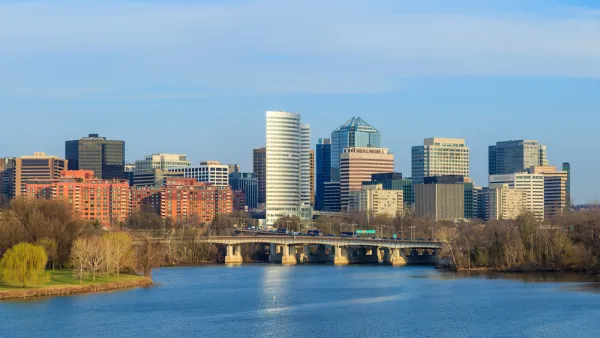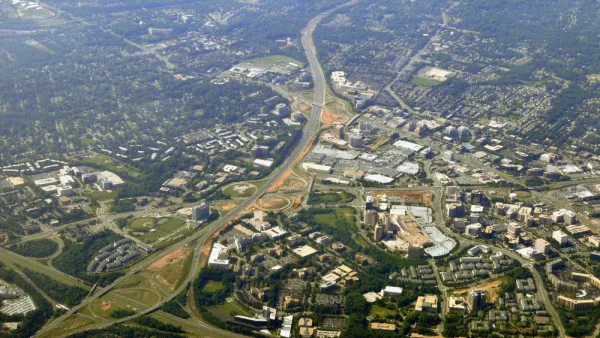In the Virginia suburbs outside of D.C., the radical plan to reshape auto-oriented Tysons Corner into vibrant, walkable Tysons is going ahead, despite skepticism that the monumental task can be accomplished, reports Corinne Reilly.
Two years into Fairfax County's four-decade plan to redevelop "a soulless, sidewalkless sea of superblocks, office buildings, highways and car dealerships" into "an urban, vibrant, walkable, downtown built around residents and rail" is beginning to move forward, block by block, writes Reilly, "[a]nd there is no turning back."
"'No one in the history of mankind has ever tried to do this' in a place that is already so developed — and developed entirely around cars and commuters, said Christopher Leinberger, with the Metropolitan Policy Program at the Brookings Institution. 'There is nowhere to look for a model for this kind of transformation.'”
"What is wrong with Tysons Corner, at least in the eyes of county officials, is what’s missing," says Reilly. "There are very few sidewalks, parks, neighborhood hangouts and places to live — none of the things that make a city a city. Instead, the 1,700-acre swath of Fairfax is home to nine times as many parking spaces as people."
"But now that the county has embarked on the redevelopment effort [seventeen redevelopment proposals are in the pipeline], some remain skeptical that such an ambitious, expensive urban retrofitting will ever come to fruition. Will anyone want to live in place long known for shopping malls and some of the region’s most horrific traffic? Will a shaky market emerging from recession support such development?"
"What is happening in Tysons is garnering interest far beyond the Washington region. If the transformation is a success, some believe it will serve as a model for rebuilding edge cities across the nation and beyond."
FULL STORY: Tysons Corner, on the verge of a do-over

National Parks Layoffs Will Cause Communities to Lose Billions
Thousands of essential park workers were laid off this week, just before the busy spring break season.

Retro-silient?: America’s First “Eco-burb,” The Woodlands Turns 50
A master-planned community north of Houston offers lessons on green infrastructure and resilient design, but falls short of its founder’s lofty affordability and walkability goals.

Delivering for America Plan Will Downgrade Mail Service in at Least 49.5 Percent of Zip Codes
Republican and Democrat lawmakers criticize the plan for its disproportionate negative impact on rural communities.

Test News Post 1
This is a summary

Test News Headline 46
Test for the image on the front page.

Balancing Bombs and Butterflies: How the National Guard Protects a Rare Species
The National Guard at Fort Indiantown Gap uses GIS technology and land management strategies to balance military training with conservation efforts, ensuring the survival of the rare eastern regal fritillary butterfly.
Urban Design for Planners 1: Software Tools
This six-course series explores essential urban design concepts using open source software and equips planners with the tools they need to participate fully in the urban design process.
Planning for Universal Design
Learn the tools for implementing Universal Design in planning regulations.
EMC Planning Group, Inc.
Planetizen
Planetizen
Mpact (formerly Rail~Volution)
Great Falls Development Authority, Inc.
HUDs Office of Policy Development and Research
NYU Wagner Graduate School of Public Service





























